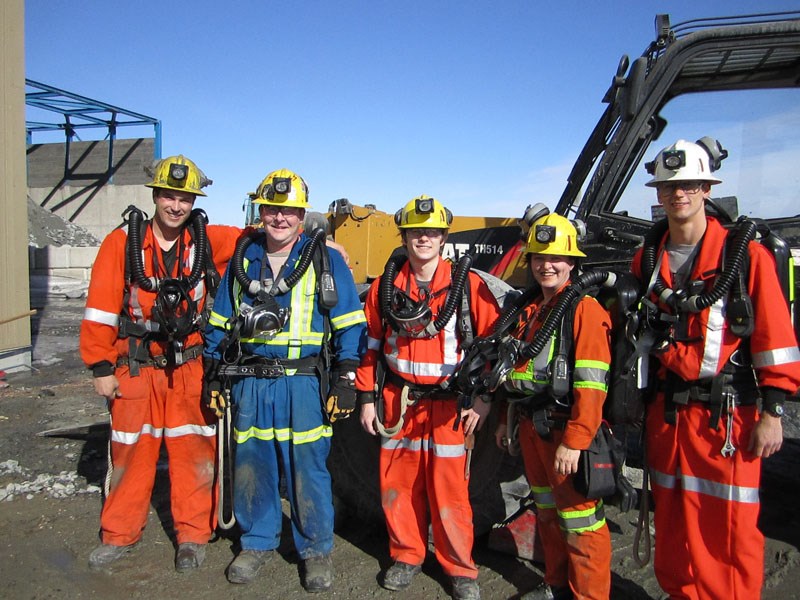Another day in the depths, or so it seemed as the Saturday, April 1 day shift began at Snow Lake’s Lalor Mine. Forty-two workers tagged in to go underground at the outset of the shift; however, shortly after 8 a.m. several workers reported seeing smoke on the 835m level of the mine. There was a request to have stench gas released and it was at 8:07 a.m. Lalor’s three mine rescue teams were notified immediately.
Such were the circumstances under which Lalor’s rescue teams would be tested during this local competition. An event that decides which team will be rewarded with the right to represent the mine at the Provincial Mine Rescue Competition, that just so happens to be scheduled for this same mine May 12-13.
Geared up and ready for their briefing, each of the three crews were sequentially apprised of the scenario. Their directors of operations explained that of the 42 people underground at the outset of the shift, 39 were safe inside the mine’s various refuge stations and the cagetender was on surface. There were no injuries to any of the workers who checked in. Nevertheless, sensors underground were picking up CO readings; there were 10 ppm on 810m level and 15 ppm on 840m level, with nothing showing up on surface. The vent fans and pumps were running normal, and if need be, the team(s) would be able to shut them down. The two men missing were heavy duty mechanics: Johnny Bigwrench and Randy Wrongwrench. The last call the men made was for a tire for their Toyota; they had a flat going to service the tele-remote scooptram on 875m level. They had not been heard from since.
The directive for the rescuers was to travel to 835m level, search for the missing workers and deal with a fire or anything else they encountered in their mission. The teams asked questions of clarification. They confirmed their channels of communication and asked about any usable equipment underground; they then synchronized their watches and re-established that the safety of the team was of prime importance. After marshalling equipment into their stretcher, they marched to the headframe, donned their facemasks and “under air” the time clock started for the assignment. They had 90 minutes to complete it.
In addition to being judged on the underground scenario, over the period of the competition, all teams were assessed on their first aid proficiency, their skill in readying their equipment, and their aptitude on a written test. Teams were scored on what they did wrong, with negative points assessed when they made any mistake on the assignment. The team with the lowest score at the end of the annual competition would be declared the winner.
With the help of base man Stephen Reid, I found the proper gear and met up with the group I would travel underground with as they left for the headframe. It was Team #1, and team captain Jonathon Young led his charges – #2 man Jodi Brasch, #3 man Judd Fey, #4 man Jeremy Campbell and vice-captain Jordan Galloway – into the cage and from there into the unknown of the underground scenario. Shortly after leaving the cage on the 835m level, the team began calling out to the missing men as they made their way to the level’s refuge station. Checked and found empty, they proceeded. As they cleared each cutout along their journey they roped it off with flagging tape, so that they weren’t “chasing their tails.”
Constantly checking in and seeking advice from their director of operations – Tony Butt on surface – the team was aware of their surroundings, ruled by their training, and wary of the hands on the clock. Many metres into their expedition they were accosted by thick smoke. This was simulated by placing masking tape eye level on their facemasks. It made the journey precarious, to say the least. They tethered themselves to the stretcher and to each other, if they needed to stray from it in order to rope off an area already checked. In the main drift, they found one of the missing men and, after checking his vitals, they determined he was deceased and moved him off the haulage to the edge of the drift. Carrying on, they found the second man. He was conscious, but it appeared his leg was injured. Working well together under these extremes, the team members administered an air pack, immediate first aid and a splint to the injured leg. They then loaded him on their stretcher and whisked him back down the drift, to the cage and up to surface. Finished with just 13 seconds left in their allotted time, the team headed to the rescue trailer for lunch, all the while mulling over where they thought they did well and not so well.
As each of the two other teams went through the same procedure, the feelings and results were somewhat the same. What varied was their reaction; however, reaction is what would determine the difference between them during this competition … and captain Jonathon Young’s “J Team” was the victorious group this day. As such, they will represent Lalor Mine and the community at the provincial contest on May 12-13 in Snow Lake.




